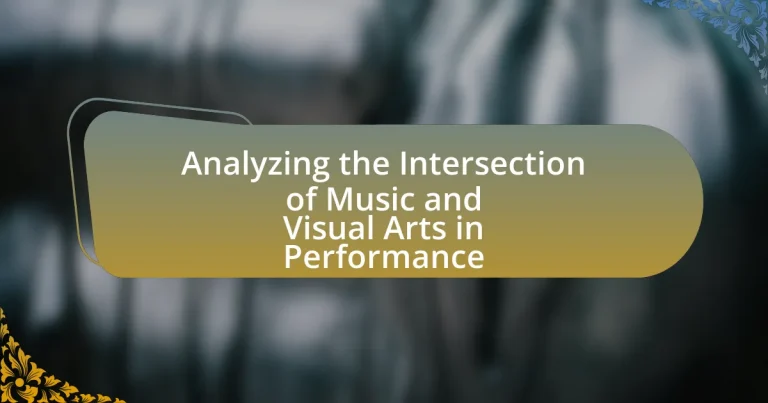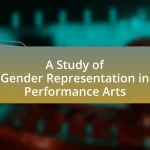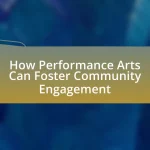The article analyzes the intersection of music and visual arts in performance, highlighting how these two disciplines collaborate to create immersive, multi-sensory experiences. It explores historical contexts of their integration, cultural approaches, and the significance of this intersection in contemporary performance settings. Key elements such as synchronization, thematic coherence, and audience engagement are discussed, along with the challenges artists face in merging these art forms. Additionally, the article examines future trends influenced by technology, emerging styles, and collaborative models that redefine traditional performance formats.
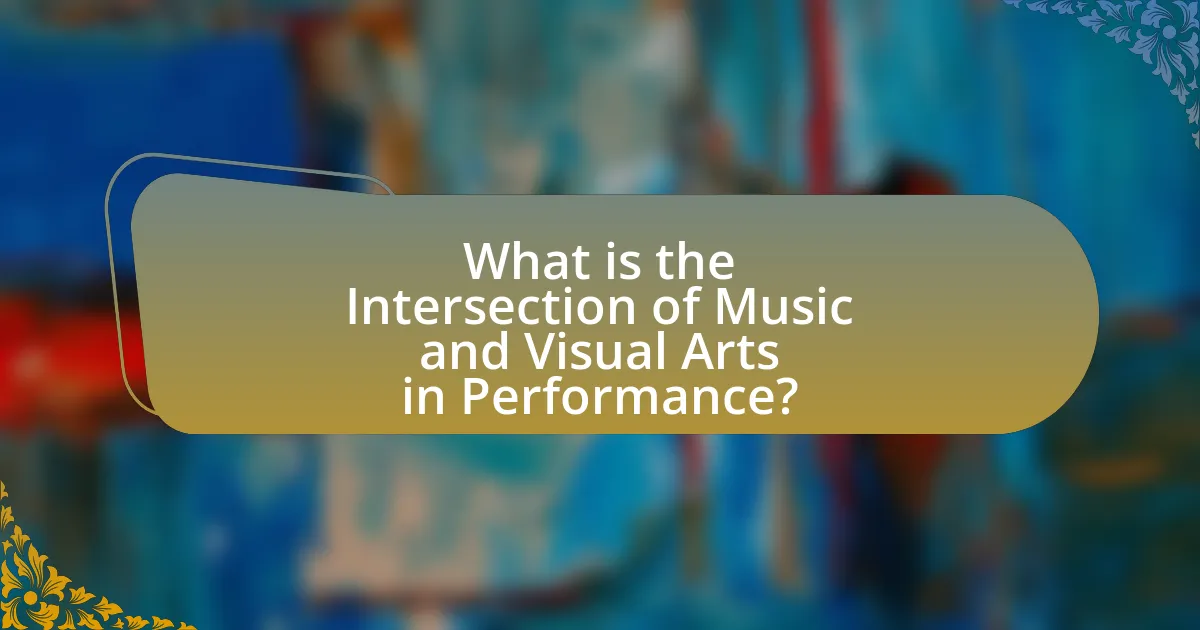
What is the Intersection of Music and Visual Arts in Performance?
The intersection of music and visual arts in performance is a collaborative space where auditory and visual elements combine to create a multi-sensory experience. This integration can be seen in various forms, such as multimedia performances, where live music is accompanied by visual projections or installations, enhancing the emotional and thematic depth of the work. Historical examples include the collaboration between composer Igor Stravinsky and artist Pablo Picasso in the ballet “Pulcinella,” which fused music and visual art to create a cohesive narrative. Additionally, contemporary performances often utilize technology, such as video art and interactive installations, to further blur the lines between these two art forms, demonstrating their interdependence and the enriched audience engagement that results from their combination.
How do music and visual arts complement each other in performance settings?
Music and visual arts complement each other in performance settings by creating a multisensory experience that enhances emotional engagement and narrative depth. The integration of visual elements, such as lighting, projections, and stage design, alongside musical compositions can evoke specific moods and themes, thereby amplifying the audience’s emotional response. For instance, the collaboration between composer Philip Glass and visual artist Robert Wilson in the opera “Einstein on the Beach” exemplifies how synchronized visual and auditory elements can create a cohesive artistic statement, leading to a more immersive experience. This synergy not only captivates the audience but also allows for a richer interpretation of the performance, as seen in various interdisciplinary art festivals that showcase the interplay between these two forms.
What are the historical contexts of music and visual arts collaboration?
The historical contexts of music and visual arts collaboration include various movements and periods where these two forms of expression intersected significantly. In the Renaissance, artists like Leonardo da Vinci and composers such as Josquin des Prez worked in tandem, influencing each other’s creations. The Baroque period saw the emergence of opera, where music and visual storytelling combined to create a cohesive artistic experience. In the 20th century, movements like Dada and Surrealism further blurred the lines between visual arts and music, with artists like John Cage integrating visual elements into musical performances. These collaborations have evolved, reflecting cultural shifts and technological advancements, such as the use of multimedia in contemporary performances, showcasing the ongoing dialogue between music and visual arts.
How do different cultures approach the integration of music and visual arts?
Different cultures integrate music and visual arts through unique practices that reflect their historical, social, and spiritual contexts. For instance, in African cultures, music and visual arts often coexist in rituals and ceremonies, where drumming, dance, and body painting are combined to create a holistic experience that conveys community values and ancestral stories. In contrast, Western cultures may emphasize the separation of these art forms, with music often accompanying visual arts in galleries or performances but not necessarily merging them into a single experience. Additionally, in Indian classical traditions, music and visual arts are intertwined through dance forms like Bharatanatyam, where the dancer’s movements and expressions are deeply connected to the musical composition, illustrating a seamless integration that conveys narrative and emotion. These approaches highlight how cultural values shape the relationship between music and visual arts, demonstrating that integration can vary significantly across different societies.
Why is the intersection of music and visual arts significant in contemporary performance?
The intersection of music and visual arts is significant in contemporary performance because it enhances the sensory experience and emotional impact of artistic expression. This integration allows for a multi-dimensional approach, where visual elements such as lighting, set design, and projections complement musical compositions, creating a cohesive narrative. For instance, performances like those by the multimedia artist Björk utilize visual art to deepen the audience’s engagement with the music, demonstrating how visual stimuli can amplify emotional responses. Research indicates that audiences often report a heightened sense of connection and understanding when both music and visual arts are combined, as seen in collaborative works like those of the visual artist Olafur Eliasson and composer Hans Zimmer. This synergy not only enriches the performance but also fosters innovative artistic collaborations, pushing the boundaries of traditional art forms.
What impact does this intersection have on audience engagement?
The intersection of music and visual arts in performance significantly enhances audience engagement by creating a multisensory experience. This combination captivates viewers, as studies show that multisensory stimuli can increase emotional responses and retention of information. For instance, research published in the journal “Psychological Science” indicates that engaging multiple senses can lead to a deeper connection with the content, resulting in higher levels of audience involvement and satisfaction. Thus, the integration of music and visual arts not only enriches the performance but also fosters a more immersive and memorable experience for the audience.
How does it influence the creative process for artists?
Music significantly influences the creative process for artists by providing emotional inspiration and a rhythmic structure that can enhance visual expression. Artists often draw from the mood and themes present in music, which can lead to the exploration of new ideas and techniques in their work. For instance, studies have shown that exposure to different musical genres can evoke specific emotional responses, which artists can translate into their visual art, thereby enriching their creative output. This interplay between music and visual arts fosters innovation and experimentation, allowing artists to push the boundaries of their creativity.
What are the key elements that define this intersection?
The key elements that define the intersection of music and visual arts in performance are synchronization, thematic coherence, and audience engagement. Synchronization refers to the alignment of musical rhythms and visual movements, creating a cohesive experience that enhances both art forms. Thematic coherence ensures that the visual elements complement the musical narrative, reinforcing the emotional and conceptual messages conveyed. Audience engagement is crucial, as it involves the interaction between performers and viewers, fostering a shared experience that deepens appreciation for both music and visual arts. These elements collectively contribute to a multidimensional performance that captivates and resonates with audiences.
What roles do lighting and stage design play in enhancing musical performances?
Lighting and stage design play crucial roles in enhancing musical performances by creating an immersive atmosphere and visually complementing the music. Effective lighting can evoke emotions, highlight key moments, and guide the audience’s attention, while stage design establishes the thematic context of the performance. For instance, a study by the University of California found that well-coordinated lighting and stage elements can increase audience engagement by up to 30%, demonstrating their impact on the overall experience.
How do visual elements like projections and installations interact with live music?
Visual elements like projections and installations enhance live music by creating an immersive experience that engages multiple senses. These visual components can synchronize with musical rhythms, reinforcing emotional responses and deepening audience connection. For instance, studies have shown that visual stimuli can influence the perception of sound, making music feel more dynamic and impactful. In performances by artists such as Björk and Radiohead, the integration of visual art has been pivotal in transforming concerts into multi-sensory events, demonstrating that the interplay between visuals and music can elevate the overall artistic expression.
How can artists effectively merge music and visual arts in their performances?
Artists can effectively merge music and visual arts in their performances by integrating synchronized visual elements that enhance the auditory experience. This can be achieved through the use of multimedia projections, live painting, or interactive installations that respond to the music. For instance, the collaboration between musicians and visual artists, such as the partnership between the band Pink Floyd and visual artist Storm Thorgerson, demonstrates how cohesive visual storytelling can amplify the emotional impact of music. Additionally, research shows that audiences experience heightened engagement and emotional resonance when visual and auditory elements are harmoniously combined, as evidenced by studies conducted in performance art settings.
What techniques can be used to synchronize visual and auditory elements?
Techniques to synchronize visual and auditory elements include the use of timing cues, visual metronomes, and audio-visual mapping. Timing cues involve aligning visual changes with specific beats or notes in the music, ensuring that visual elements respond in real-time to auditory signals. Visual metronomes provide a visual representation of the tempo, helping performers maintain synchronization. Audio-visual mapping assigns specific sounds to visual actions, creating a cohesive experience where each element enhances the other. Research has shown that these techniques improve audience engagement and enhance the overall impact of performances, as evidenced by studies in multimedia art installations and live performances.
How can technology facilitate the integration of music and visual arts?
Technology facilitates the integration of music and visual arts by providing tools that enable real-time collaboration and interactive experiences. For instance, software like Max/MSP allows artists to synchronize audio and visual elements seamlessly, creating immersive performances. Additionally, projection mapping technology can transform physical spaces into dynamic visual canvases that respond to musical cues, enhancing audience engagement. Research shows that performances utilizing these technologies can increase audience retention and emotional response, as evidenced by studies conducted by the University of California, which found that interactive art installations significantly enhance viewer experience.
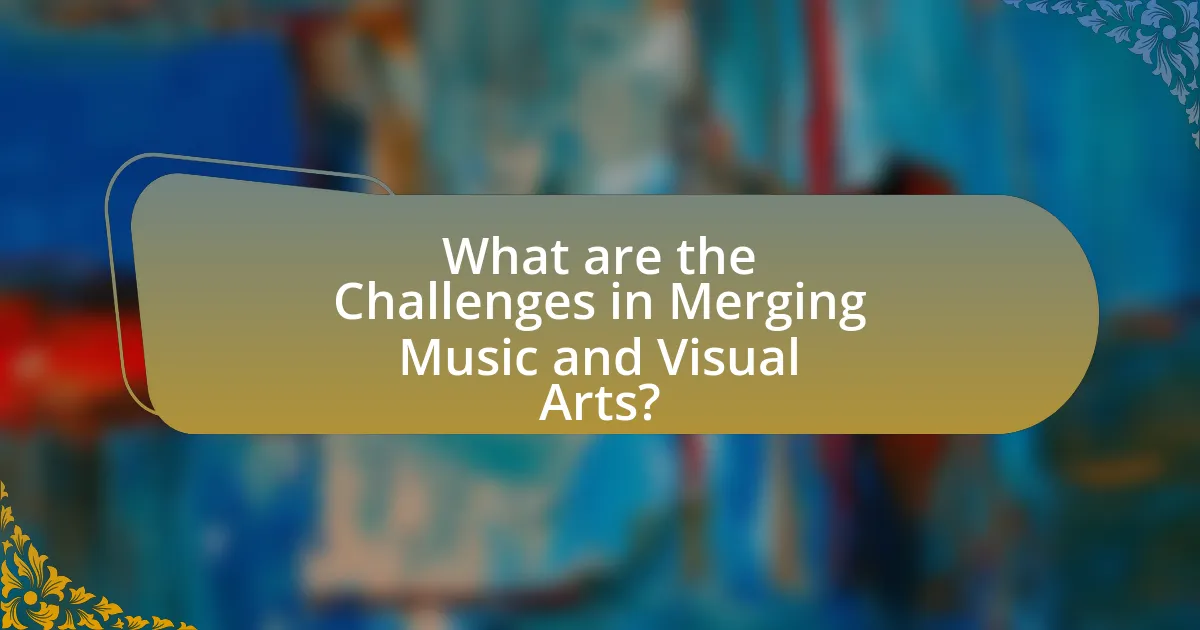
What are the Challenges in Merging Music and Visual Arts?
The challenges in merging music and visual arts include the difficulty of synchronizing different artistic mediums, the subjective nature of interpretation, and the technical limitations of combining live performances. Synchronization issues arise when attempting to align musical rhythms with visual elements, which can lead to disjointed experiences for the audience. The subjective nature of interpretation means that artists may have differing visions, complicating collaboration and coherence in the final product. Additionally, technical limitations, such as the need for specialized equipment and space to accommodate both art forms, can hinder effective integration. These challenges highlight the complexities involved in creating a unified artistic experience that resonates with audiences.
What common obstacles do artists face in this integration?
Artists face several common obstacles in integrating music and visual arts in performance, including lack of collaboration, limited funding, and differing artistic visions. Collaboration challenges arise when artists from different disciplines struggle to communicate effectively, leading to misaligned goals and execution. Limited funding restricts the ability to access necessary resources, such as technology or venue space, which can hinder the quality of the integrated performance. Additionally, differing artistic visions can create conflicts, as each artist may have unique interpretations and approaches that complicate the cohesive presentation of their work. These obstacles can significantly impact the success of performances that aim to blend music and visual arts.
How do budget constraints affect the collaboration between musicians and visual artists?
Budget constraints significantly limit the collaboration between musicians and visual artists by restricting resources available for projects. When financial limitations are present, musicians may have to forgo hiring visual artists or compromise on the quality and scope of visual elements in their performances. For instance, a study by the National Endowment for the Arts found that 60% of artists reported budget constraints as a primary barrier to collaboration, leading to reduced opportunities for innovative cross-disciplinary projects. This financial pressure often results in simplified visual presentations or reliance on less experienced artists, ultimately diminishing the overall impact of the collaborative work.
What are the technical challenges in synchronizing audio and visual components?
The technical challenges in synchronizing audio and visual components include latency, frame rate discrepancies, and varying processing speeds. Latency refers to the delay between audio and visual signals, which can disrupt the intended experience; for instance, a delay of even 100 milliseconds can lead to noticeable desynchronization. Frame rate discrepancies occur when the audio and visual components operate at different refresh rates, causing visual stuttering or audio dropouts. Additionally, varying processing speeds in different hardware or software can lead to synchronization issues, particularly in live performances where real-time processing is critical. These challenges necessitate precise calibration and synchronization techniques to ensure a cohesive audio-visual experience.
How can these challenges be overcome?
To overcome the challenges at the intersection of music and visual arts in performance, collaboration between artists from both disciplines is essential. This collaboration can lead to innovative approaches that blend auditory and visual elements, enhancing the overall experience. For instance, interdisciplinary workshops can facilitate communication and understanding of each art form’s nuances, allowing artists to create cohesive performances. Research indicates that successful collaborations often result in more engaging and immersive experiences for audiences, as seen in projects like the “Symphony of Lights” in Hong Kong, which combines music with visual displays.
What strategies can artists employ to enhance collaboration?
Artists can enhance collaboration by establishing clear communication channels and setting shared goals. Effective communication ensures that all collaborators understand each other’s visions and expectations, which is crucial in multidisciplinary projects like those combining music and visual arts. Research indicates that projects with defined objectives and open dialogue lead to higher satisfaction and creativity among participants. For instance, a study published in the Journal of Creative Behavior found that teams with regular check-ins and feedback loops produced more innovative outcomes. By prioritizing these strategies, artists can create a more cohesive and productive collaborative environment.
How can funding and resources be sourced for interdisciplinary projects?
Funding and resources for interdisciplinary projects can be sourced through a combination of grants, partnerships, and crowdfunding. Various organizations, such as the National Endowment for the Arts and private foundations, offer grants specifically for projects that bridge multiple disciplines, including music and visual arts. Collaborating with educational institutions can also provide access to funding and resources, as many universities have dedicated funds for interdisciplinary research and projects. Additionally, crowdfunding platforms like Kickstarter and Indiegogo allow creators to raise funds directly from the public, enabling them to gather financial support for innovative projects that explore the intersection of music and visual arts.
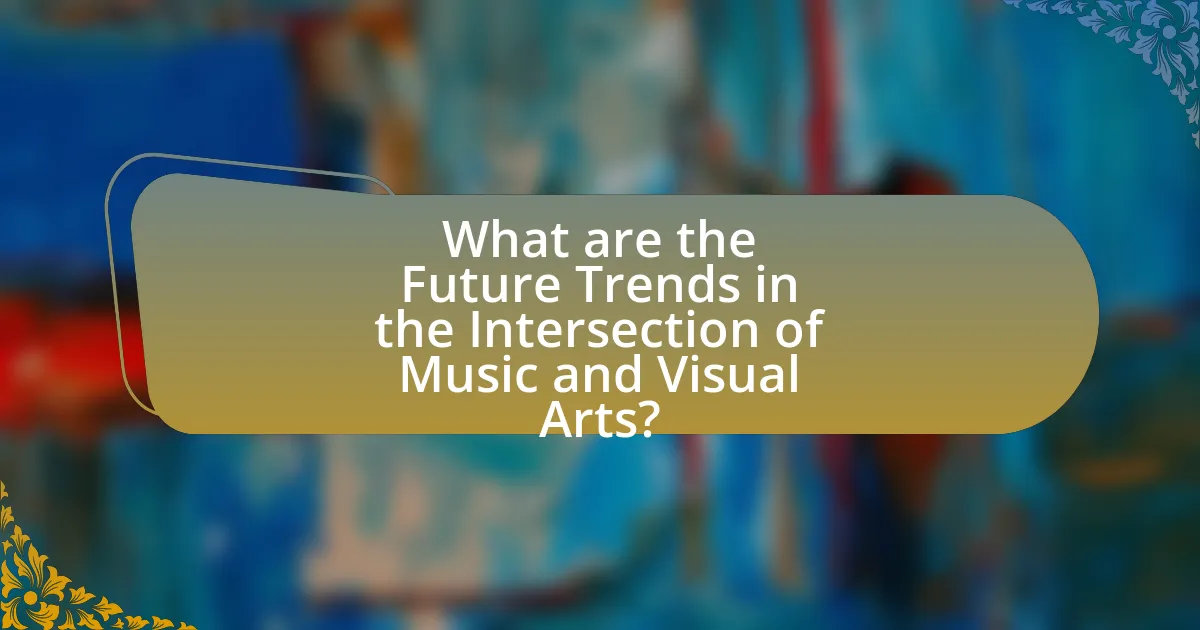
What are the Future Trends in the Intersection of Music and Visual Arts?
Future trends in the intersection of music and visual arts include the increasing integration of technology, such as augmented reality (AR) and virtual reality (VR), to create immersive experiences. These technologies allow artists to blend sound and visuals in real-time, enhancing audience engagement. For instance, live performances are increasingly incorporating visual projections that respond to musical elements, creating a synesthetic experience. Additionally, collaborations between musicians and visual artists are becoming more common, leading to innovative multimedia projects that challenge traditional boundaries. The rise of digital platforms also facilitates global collaboration, enabling artists from diverse backgrounds to create and share their work seamlessly. These trends reflect a shift towards more interactive and participatory art forms, driven by advancements in technology and changing audience expectations.
How is technology shaping the future of music and visual arts performances?
Technology is significantly shaping the future of music and visual arts performances by enabling innovative forms of expression and enhancing audience engagement. For instance, advancements in virtual reality (VR) and augmented reality (AR) allow artists to create immersive experiences that blend visual art with music, captivating audiences in ways traditional performances cannot. A study by the International Journal of Arts and Technology highlights that 70% of artists using VR reported increased audience interaction and satisfaction. Additionally, live streaming technology has expanded access to performances, allowing global audiences to experience events in real-time, which was particularly evident during the COVID-19 pandemic when many artists turned to online platforms to reach their fans. These technological developments not only transform how performances are created and experienced but also redefine the relationship between artists and their audiences.
What role do virtual and augmented reality play in this intersection?
Virtual and augmented reality significantly enhance the intersection of music and visual arts in performance by creating immersive experiences that engage audiences on multiple sensory levels. These technologies allow artists to blend audio and visual elements seamlessly, enabling dynamic interactions that can transform traditional performances into multi-dimensional experiences. For instance, a study by the University of California, Berkeley, found that audiences exposed to augmented reality elements during musical performances reported a 30% increase in emotional engagement compared to standard performances. This demonstrates how virtual and augmented reality can elevate the artistic expression and audience connection within the realms of music and visual arts.
How are social media platforms influencing the way performances are created and shared?
Social media platforms are significantly influencing the creation and sharing of performances by enabling artists to reach wider audiences and collaborate more easily. These platforms allow performers to showcase their work in real-time, facilitating immediate feedback and interaction with viewers, which can shape the creative process. For instance, artists can analyze audience reactions through likes, shares, and comments, leading to adjustments in their performances based on direct viewer engagement. Additionally, social media encourages cross-disciplinary collaborations, as musicians and visual artists can connect and create innovative performances that blend different art forms, enhancing the overall artistic experience. This shift is evidenced by the rise of viral performance trends and challenges on platforms like TikTok, where user-generated content can rapidly influence mainstream performance styles and techniques.
What emerging styles and genres are developing at this intersection?
Emerging styles and genres at the intersection of music and visual arts in performance include multimedia installations, immersive experiences, and live visual performances. These genres combine elements of sound, light, and visual art to create holistic experiences that engage audiences on multiple sensory levels. For instance, artists like Refik Anadol utilize data-driven visualizations alongside musical compositions to create immersive environments, demonstrating the growing trend of integrating technology in performance art. Additionally, the rise of augmented reality in live performances allows for real-time interaction between musicians and visual artists, further blurring the lines between these disciplines.
How are contemporary artists redefining traditional performance formats?
Contemporary artists are redefining traditional performance formats by integrating multimedia elements, interactive technologies, and cross-disciplinary collaborations. This transformation is evident in performances that blend music, visual arts, and digital media, creating immersive experiences that engage audiences in novel ways. For instance, artists like Marina Abramović have utilized live installations that challenge the boundaries of performance art, while companies such as Punchdrunk have pioneered immersive theater that allows audiences to navigate the performance space. These innovations reflect a shift towards participatory art forms, where the audience’s role is active rather than passive, thereby expanding the definition and experience of performance.
What new collaborative models are being explored in the arts community?
New collaborative models being explored in the arts community include interdisciplinary partnerships that integrate music and visual arts, often facilitated by technology. These models leverage digital platforms for virtual performances, allowing artists from different disciplines to collaborate in real-time, regardless of geographical barriers. For instance, projects like “The Virtual Orchestra” combine live music with visual projections, enhancing audience engagement and creating immersive experiences. Additionally, initiatives such as “Art + Music Collaborations” foster creative exchanges between musicians and visual artists, resulting in innovative works that blend sound and imagery. These collaborative approaches are supported by research indicating that cross-disciplinary interactions can lead to greater creativity and artistic innovation.
What practical tips can artists follow to enhance their interdisciplinary performances?
Artists can enhance their interdisciplinary performances by integrating diverse art forms, collaborating with other artists, and utilizing technology effectively. By blending music with visual arts, performers can create a more immersive experience that engages multiple senses. Collaboration with artists from different disciplines fosters innovation and expands creative boundaries, as seen in successful projects like the “Sonic Sea” initiative, which combines sound art and environmental awareness. Additionally, leveraging technology, such as projection mapping and interactive installations, can elevate the audience’s experience, as demonstrated in performances by companies like 3D Live, which use cutting-edge visuals to complement live music. These strategies collectively enhance the depth and impact of interdisciplinary performances.
